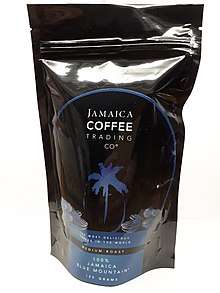Jamaican Blue Mountain Coffee
Jamaican Blue Mountain Coffee or Jamaica Blue Mountain Coffee is a classification of coffee grown in the Blue Mountains of Jamaica. The coffee was introduced to Jamaica in 1728.[1]

The best lots of Blue Mountain coffee are noted for their mild flavour and lack of bitterness. Over the past few decades, this coffee has developed a reputation that has made it one of the most expensive and sought-after coffees in the world. Over 80% of all Jamaican Blue Mountain Coffee is exported to Japan.[2] In addition to its use for brewed coffee, the beans are the flavour base of Tia Maria coffee liqueur.
Jamaican Blue Mountain Coffee is a globally protected certification mark, meaning only coffee certified by the Jamaica Commodities Regulatory Authority [3] (previously the Coffee Industry Board of Jamaica) can be labelled as such. It comes from a recognised growing region in the Blue Mountain region of Jamaica, and its cultivation is monitored by the Coffee Industry Board of Jamaica.
The Blue Mountains are generally located between Kingston to the south and Port Antonio to the north. Rising to 2,256 metres (7,402 ft), they are some of the highest mountains in the Caribbean. The climate of the region is cool and misty with high rainfall. The soil is rich, with excellent drainage. This combination of climate and soil is considered ideal for coffee.[4]
The Coffee Industry Regulation Act
The Coffee Industry Regulation Act specifies what coffee may use the Blue Mountain label. Additionally, it restricts the use of the Blue Mountain trademark to those authorized by the Jamaica Agricultural Commodities Regulatory Authority (formerly the Coffee Industry Board). Broadly speaking, coffee harvested from the parishes of Saint Andrew, Saint Thomas, Portland and Saint Mary may be considered Blue Mountain coffee.[5]
Traditionally, only coffee grown at elevations between 910 metres (3,000 ft) and 1,700 metres (5,500 ft) could be called Jamaica Blue Mountain. Coffee grown at elevations between 460 metres (1,500 ft) and 910 metres (3,000 ft) is called Jamaica High Mountain, and coffee grown below 460 metres (1,500 ft) elevation is called Jamaica Supreme or Jamaica Low Mountain. (All land in Jamaica above 1,700 metres (5,500 ft) is a forest preserve, so no coffee is grown there.)
Classifications of Blue Mountain Coffee
There are generally three types of grades of Jamaica Blue Mountain ranked by size and defects. Number 1 beans as the largest and most desired with least defects, followed by number 2 and 3 beans. Separately, there are peaberry beans which are smaller beans which appear shaped as a rugby ball as opposed to the usual flat beans.[6]
As with most other varieties of coffee, there are several grades assigned to different lots, based on factors such as size, appearance, and defects allowed.[7]
References
- "Jamaican Blue Mountain Coffee Guide: All You Need To Know". January 9, 2020.
- "Embassy of Jamaica - Tokyo". Archived from the original on 2017-02-21. Retrieved 2010-02-27.
- "Background – Jamaica Agricultural Commodities Regulatory Authority". Retrieved 2020-08-14.
- "Jamaica Blue Mountain Coffee: The History, 2020" Eighty Seven Plus Coffee
- "Rules & Regulations—Coffee Industry Board". Archived from the original on 2001-12-22.
- "Jamaican Coffee". wwwchem.uwimona.edu.jm.
- "The Jamaican Coffee Industry Board Quality Certification Process". Archived from the original on 2016-03-04. Retrieved 2015-04-13.
External links
- The Coffee Industry Board of Jamaica
- "Blue Mountain Blues". Specialty Coffee Association of Europe. 2006-02-21. Archived from the original on 2006-03-13. Article about hurricane damage to the Jamaican crop.
